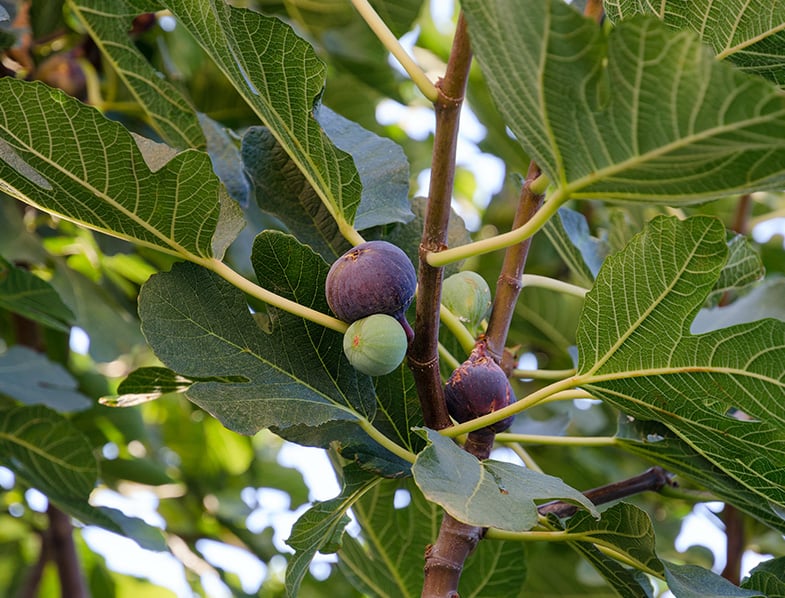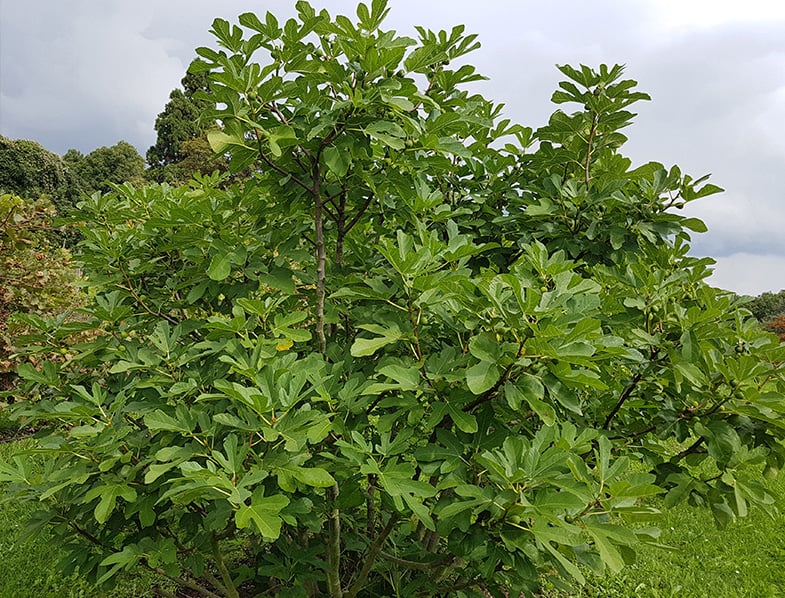Despite its name, there is nothing common about the Common Fig. This is one of the most interesting Mediterranean fruit shrubs. In environments similar to its natural habitat, it can easily be grown outdoors with minimum effort. In areas with harsher winters, it can also be grown in pots. Moreover, if you are skilled with pruning scissors, this exotic shrub can even be grown as a bonsai tree.
The Fig belongs to the Mulberry family, known as Moraceae or the Fig Family. It is quite a large family, comprising of 38 genera and over 1100 species. All of the species in this family have milky sap and a secretory cell in the leaves that produces latex. But the fig tree that we know and love is a crossed tree of many species from South-Western Asia.
About the Common Fig
- This is an ancient plant and the origins of its name are hard to track. Many believe that the word fig comes from the “fica” word in Romance or the “ficus” word in Latin. It can also be traced back to the Greek word “sykos”.
- Ficus Carica is believed to be one of the first plants cultivated by humans. Several fig fossils were discovered that date back to 9400 BC. Later on, the fig became very popular in ancient Greece and it quickly spread all over the world in suitable environments. A Fig variety was even brought to California in the 1700s.
- In northern areas, the Common Fig is grown as an ornamental tree and it has even gained the Royal Horticultural Society’s Award of Garden Merit.
- The Common Fig is a deciduous tree with a rare breeding system known as Gynodioecy. This is a middle stage between hermaphroditism and dioecy. It is a genetic mutation that keeps hermaphroditic plants from producing pollen. Both female and hermaphroditic plants can be found within a population. However, cultivated species have mostly female flowers. The wild trees have both male and female flowers, but they bear non-edible fruits.
- As we already mentioned, the Common Fig is a crossed tree of different species, most of which grow wild in Iran, India, or Arabia. The most popular wild species are Ficus Virgata, Ficus Palmata, and Ficus Serrata.
- The most curious thing about the fig tree is that it has a unique way to produce flowers. The flowers grow within a pouch-shaped syconium and they don’t need pollination to grow the sugary pulp that turns into the fruit that we know.
- The Common Fig tree prefers rocky locations in sunny climates. Usually, it can be found at over 1700 meters above sea level. It has a very aggressive root system which helps it grow even in inhospitable locations, but it is this same root system that prevents it from growing in urban locations. It needs a lot of water, so it is common to find it around river valleys. However, its strong roots can find water even in rock cracks.
- There is even a Rock Fig variety which can be found in semi-arid locations in Iran.
- Fig fruits are edible, and they are consumed by both humans and animals. In fact, in the wild, it is the consumption of the fruits by the local fauna that helps the fig tree spread its seed.
- The fruits have a high percentage of carbohydrates and very little fat. They are also delicious and a source of nutrients and fiber.
- The milky sap of the Fig tree has been used in alternative medicine to remove warts and soften calluses. But handle it with caution, because it can be toxic and it can cause skin inflammation.

Common Fig Features: An Overview
- A mature fig tree will grow about 7-10 meters tall. It has smooth, white bark and its trunk can grow up to 90 cm in diameter. It can live as long as 200 years.
- Ficus Carica has fragrant leaves that grow to up to 25 cm in length and 18 cm in width. The leaves have three or five lobes.
- Fruits occur in fall or summer, depending on the temperatures and environment, and some trees can bear fruits in both seasons.
- Fig trees produce syconia, which are receptacles shaped like urns that contain dozens or even thousands of female flowers. A syconium is not actually a fruit, but an infructescence, which is a multitude of fruits. The infructescence contains a narrow passage that allows the fig wasp to enter and pollinate the flowers. After pollination, each flower will have a fertilized ovule which develops into a seed.
- Wild trees contain both female and male flowers. Their fruits are not edible, and they can be recognized by their smaller leaves.
- There are three types of edible fig fruits. One type is the one pollinated by the fig -wasp. Another type is the one which has all-female flowers and doesn’t need pollination. The last type comes from the Breba crops, which develop from unpollinated flowers but need pollination for the following crops.
Growing the Common Fig
Ficus Carica grows in warm, temperate regions. It prefers porous soil with good draining properties and it can grow well even in soils with little nutrients. This tree will need at least 8 hours of direct sunlight to thrive. It needs plenty of water, but it also needs a dry season as well as a cold season. Keep in mind that a young tree can die during a chilly winter, so it is best to grow it in a pot until it is about 5 years old. Winter mulching is a great way to help a fig tree survive winter.
Ficus Carica grows relatively fast, so if you grow it in a pot, you will have to repot it every two years. Even if your shrub doesn’t outgrow its pot, it is still necessary to replace most of the soil in the pot every three years.

If you want to plant your Ficus Carica outdoors, remember that it has a very invasive root system. The roots can choke the nearby plants and they can even damage sidewalks and fences. You can prevent roots from being too invasive by building some underground retaining walls.
This tree will require regular pruning, but only during the first years. Ideally, you should prune it before the spring blossoms. Once the tree’s form is established, avoid pruning it, as you can affect the crop. Fig trees have a toxic milky sap, so wear protective gloves when pruning them.
Watering the Common Fig
When grown outdoors, the Common Fig tree will get the necessary water from rain and underground sources. However, do water your fig tree if you notice signs of stress because its water requirements can differ based on the weather or the soil nutrients. Potted trees should be watered weekly. For optimal results, dig a 10 cm deep moat around the base of your tree and pile the soil around the edges of the mot to keep the water in. Water it for about 45 minutes each week.
Potted trees need more frequent watering. It is best to water them once every couple of days. Reduce watering frequency as the weather gets colder. During the wintertime, when the trees are dormant, they only need to be watered once a month.
Propagating the Common Fig
Ficus carica can be propagated from seed, but since this is time-consuming and has lower chances of success, most cultivators choose to propagate through hardwood cuttings. The cuttings should be collected in early spring and they should be taken from 2-3-year-old shouts. You can increase your chances of success by girdling your shoots a month before cutting them. To do this, remove only a thin layer of bark from the lower inch of the shoot. Use a rooting hormone and wrap polyethylene and aluminum around the shoot.

Premium Cuttings Ficus Carica Tree, From Amazon
The cutting should be about 25 cm long and 1,5 cm thick and they should include at least 2 nods, one at the base and one at the top. Apply a rooting hormone, and allow the cutting about 10 days to develop a callous. During this time, you can place it in slightly moist peat.
Use a peat perlite mix as the medium for your nursery bed and allow the new plant about a year and a half to develop proper roots. If you plant a fig tree directly outdoors, you won’t have to irrigate it, but if you expect it to catch roots indoors, you will have to mist it regularly.
In Conclusion
The fig is one of the most exotic fruits. It can be eaten fresh or dried, it makes for a delicious jam and it can be incorporated in many sweets. Moreover, the Ficus Carica tree is very visually pleasing.
So, whether you want to grow it for its fruits or ornamental purposes, this tree can be very rewarding. Keep in mind that it is a rather demanding tree. It requires a specific climate and plenty of natural sunlight. Consider all the aspects that we detailed here before you decide if your garden or your patio can accommodate the Common Fig.
Are you growing fig trees in your garden? Share your experience in the comments below!
